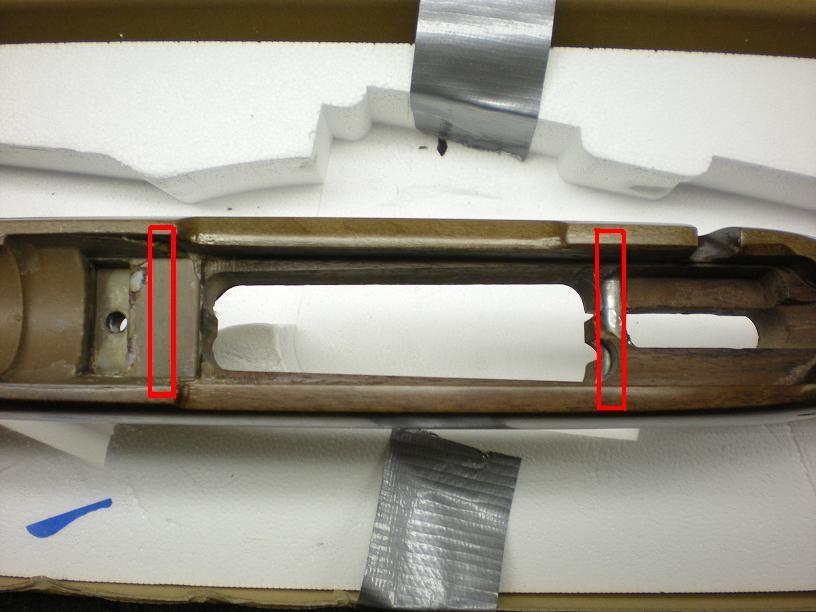sable tireur
Well-Known Member
- Joined
- Oct 8, 2010
- Messages
- 3,413
This is jumping back and forth between the two stocks you're asking about. To simplify all the answers:
The original CZ stock cracked at the cross bolt should not be repaired as it is a grain/structural flaw and will fail again. CZ will stand behind this although switching to a synthetic stock will give them pause for thought.
The second stock you had made is cracked from the action screw out and up through a fault in the grain structure. It can be repaired but it will most likely not perform as you would like it to. It's a flaw which affects the way the barreled action interacts with that stock in an area where pressure is exerted on the barreled action by the action screws through the flaw in that stock. Yes, you can bed it but to what end? Average to mediocre performance? Or just so you can have it cobbled back together.
Professional stockmakers should be your choice for inletting, cross bolts and bedding. Cobbling projects together often results in lesser performance. Cross bolts have been used for a 100 years on the heaviest recoiling rifles ever fielded on every continent without failure when done properly by professionals. Here is a short detailed explanation:
http://www.hallowellco.com/recoil_crossbolts.htm
Illustration for dual cross bolt placement:

An explanation from a highly regarded (yet anonymous) stockmaker:
"The primary area for a split to start is actually through the web of wood right behind the magazine box. This is where your first crossbolt should go.
The reason is this: when fired, the recoil force is transmitted to the stock via the action's recoil lug. The recoil lug moves the wood rearward over the wide area behind it but then, behind that, the stock is divided into two parts to go around the magazine box. The tendency is for the now-separated wood sides to try to momentarily spread & separate further under recoil, and the rear web behind the mag box is a LOT smaller than the front web behind the recoil lug.
I like pillar glass-bedding with a hidden crossbolt behind the mag box and I believe you will too."
He makes a point of mentioning pillars as well as bedding and cross bolts. Mausers had a form of pillar bedding and this process is now a common practice with wood and synthetic stocks for most gunmakers.
No matter what the resolution is with CZ, be sure to use a professional stockmaker or custom riflesmith to have your rifle pillar bedded and cross bolts installed.
Happy Father's Day to everyone!
The original CZ stock cracked at the cross bolt should not be repaired as it is a grain/structural flaw and will fail again. CZ will stand behind this although switching to a synthetic stock will give them pause for thought.
The second stock you had made is cracked from the action screw out and up through a fault in the grain structure. It can be repaired but it will most likely not perform as you would like it to. It's a flaw which affects the way the barreled action interacts with that stock in an area where pressure is exerted on the barreled action by the action screws through the flaw in that stock. Yes, you can bed it but to what end? Average to mediocre performance? Or just so you can have it cobbled back together.
Professional stockmakers should be your choice for inletting, cross bolts and bedding. Cobbling projects together often results in lesser performance. Cross bolts have been used for a 100 years on the heaviest recoiling rifles ever fielded on every continent without failure when done properly by professionals. Here is a short detailed explanation:
http://www.hallowellco.com/recoil_crossbolts.htm
Illustration for dual cross bolt placement:
An explanation from a highly regarded (yet anonymous) stockmaker:
"The primary area for a split to start is actually through the web of wood right behind the magazine box. This is where your first crossbolt should go.
The reason is this: when fired, the recoil force is transmitted to the stock via the action's recoil lug. The recoil lug moves the wood rearward over the wide area behind it but then, behind that, the stock is divided into two parts to go around the magazine box. The tendency is for the now-separated wood sides to try to momentarily spread & separate further under recoil, and the rear web behind the mag box is a LOT smaller than the front web behind the recoil lug.
I like pillar glass-bedding with a hidden crossbolt behind the mag box and I believe you will too."
He makes a point of mentioning pillars as well as bedding and cross bolts. Mausers had a form of pillar bedding and this process is now a common practice with wood and synthetic stocks for most gunmakers.
No matter what the resolution is with CZ, be sure to use a professional stockmaker or custom riflesmith to have your rifle pillar bedded and cross bolts installed.
Happy Father's Day to everyone!
